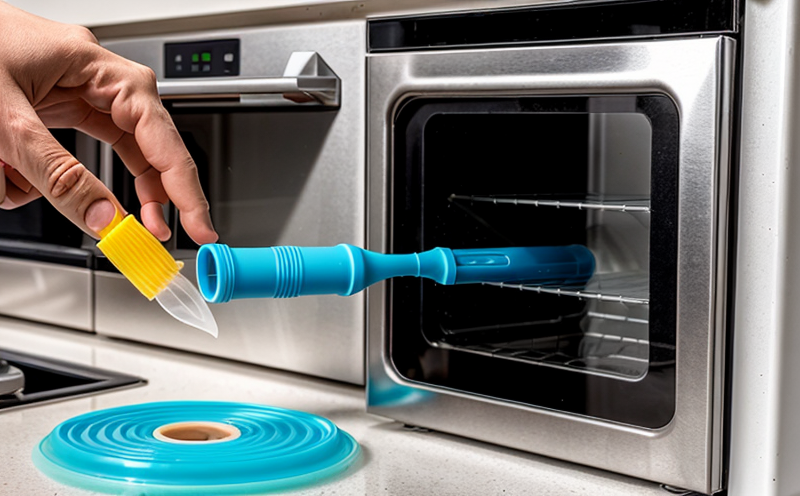ASTM D542 Transparency Testing of Household Plastics
The ASTM D542 Transparency Test is a critical procedure for evaluating the clarity and transparency characteristics of plastic materials, particularly in household applications. This test is essential for manufacturers to ensure that their products meet industry standards and customer expectations regarding visual quality.
The test involves measuring the light transmittance through the material using a transmission densitometer. The instrument measures how much light passes through a given sample, providing an accurate assessment of its transparency. The result is expressed as a percentage, where 100% indicates complete transparency and 0% represents total opacity.
This service is particularly important for household plastics because it helps manufacturers understand the optical properties of their products. For instance, transparent plastic containers are used in food storage to allow consumers to see the contents easily. If these containers lack sufficient transparency, they may not meet consumer expectations or regulatory requirements.
The ASTM D542 test is also relevant for other household applications like decorative items, toys, and packaging materials where visual clarity can impact user satisfaction. Understanding how light interacts with plastic helps in optimizing design and manufacturing processes to meet both aesthetic and functional needs.
Properly performing this test requires careful preparation of the samples. Specimens should be cut into standard sizes (typically 1" x 2" or 25mm x 50mm) and conditioned according to ASTM standards. Conditioning involves maintaining the sample at a specific temperature and humidity level for a defined period before testing.
The instrument used for this test must comply with ASTM specifications, ensuring accurate and reproducible results. The densitometer should have a stable light source and precise measurement capabilities to provide reliable data.
Once the samples are prepared and conditioned, they are placed in the transmission densitometer. The device measures the amount of light transmitted through the sample at various wavelengths. The most common wavelength used for household plastics is 589 nanometers, corresponding to sodium light.
The results from this test can be used by quality managers to ensure that products meet internal specifications and external standards like ASTM D542. Compliance officers can use these data points to verify that their products comply with relevant regulations.
R&D engineers benefit greatly from this service as it provides insights into material selection for new product developments. It also helps in troubleshooting issues related to light transmission during the manufacturing process. For procurement personnel, understanding the transparency of materials ensures they are selecting suppliers who meet quality standards.
Scope and Methodology
| Scope | Description |
|---|---|
| Determination of Light Transmittance | The ASTM D542 test measures the percentage of light transmitted through a plastic sample. This helps in assessing the clarity and transparency of household plastics. |
| Sample Preparation | Standardized specimens are prepared, conditioned at specific temperature and humidity levels, then measured using a transmission densitometer. |
| Instrumentation | A transmission densitometer is used to measure light transmittance. This instrument should meet ASTM specifications for accuracy and stability. |
| Methodology | Description |
|---|---|
| Sampling | Select representative samples from the batch to be tested. Ensure that these samples are free from defects and contamination. |
| Conditioning | Place the samples in a controlled environment for a set period, typically 48 hours at 23°C ± 2°C and relative humidity of 50% ± 10%. This ensures that any moisture content does not affect the test results. |
| Measurement | Insert the conditioned samples into the transmission densitometer. Measure light transmittance at a wavelength of 589 nm, which corresponds to sodium light. |
| Data Interpretation | Analyze the results against ASTM D542 standards. Ensure that all measurements fall within acceptable ranges for your specific application. |
Benefits
Ensures product quality by meeting transparency requirements specified in industry standards like ASTM D542.
Aids in compliance with regulatory and safety requirements, which is crucial for household products.
Improves customer satisfaction as transparent materials enhance the visual appeal of products.
Supports research and development efforts by providing data on light interaction with plastic materials.
Facilitates effective procurement decisions by ensuring suppliers meet quality standards for transparency.
Reduces production errors by identifying issues related to light transmission early in the manufacturing process.
Industry Applications
| Application | Description |
|---|---|
| Film & Wrapping Materials | Transparency is vital for films used in packaging to ensure that contents are visible. |
| Containers | Transparent containers, like those used for food storage or beverages, rely on high light transmittance. |
| Decorative Items | Clear decorative items enhance aesthetic appeal and customer satisfaction. |
| Toys & Games | Transparency in toys can contribute to a child's learning experience by allowing them to see the inner workings of the toy. |
The ASTM D542 test is widely used across various sectors, ensuring that household plastics meet the highest quality standards. By adhering to this testing protocol, manufacturers can confidently produce products that not only comply with regulatory requirements but also exceed customer expectations in terms of visual quality.





